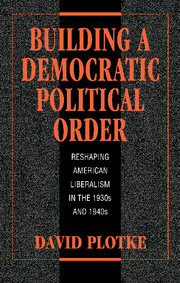Book contents
- Frontmatter
- Contents
- Preface
- Introduction: The Democratic order as a political project
- 1 When does politics change?
- 2 Creating political orders: the logic of the Democratic experience
- 3 Democratic opportunities in the crises of the 1930s
- 4 Passing the Wagner Act and building a new Democratic state
- 5 Party and movements in the Democratic upsurge, 1935–7
- 6 Progressive liberalism as pragmatic common sense
- 7 Surprising years: electing Truman and sustaining the Democratic order, 1947–9
- 8 Passing Taft-Hartley: what the losers won (and what the winners lost)
- 9 New political fronts? growth and civil rights in the 1940s
- 10 Democratic anti-Communism and the Cold War
- 11 From Truman to Kennedy: the reach and limits of Democratic power
- 12 Was the Democratic order democratic?
- Index
10 - Democratic anti-Communism and the Cold War
Published online by Cambridge University Press: 17 September 2009
- Frontmatter
- Contents
- Preface
- Introduction: The Democratic order as a political project
- 1 When does politics change?
- 2 Creating political orders: the logic of the Democratic experience
- 3 Democratic opportunities in the crises of the 1930s
- 4 Passing the Wagner Act and building a new Democratic state
- 5 Party and movements in the Democratic upsurge, 1935–7
- 6 Progressive liberalism as pragmatic common sense
- 7 Surprising years: electing Truman and sustaining the Democratic order, 1947–9
- 8 Passing Taft-Hartley: what the losers won (and what the winners lost)
- 9 New political fronts? growth and civil rights in the 1940s
- 10 Democratic anti-Communism and the Cold War
- 11 From Truman to Kennedy: the reach and limits of Democratic power
- 12 Was the Democratic order democratic?
- Index
Summary
Present Soviet policy can be roughly described as a policy of kicking at doors. If the doors fly open, the USSR moves in. But, if the doors are locked, the USSR does not break down the door because it does not want to get involved in a fight with the householder or its friends. The policy of the Truman Doctrine is a policy of locking doors against Soviet aggression.
– Arthur Schlesinger, Jr., 1949Long and passionate controversies surround the origins of the Cold War, its effects on American politics, and the meaning of domestic political campaigns against Communism. This chapter assesses the Democratic order in relation to the international setting of the late 1940s. Old debates are not made irrelevant by the end of the Cold War but rather reignited, combined with new questions when the premise of a strong and enduring Soviet Union no longer exists. The meaning of the events this chapter discusses is still in part being established by contemporary political conflicts whose result is uncertain. Durable orthodoxies have been destabilized by the surprising course of events in Eastern Europe and the countries of the former Soviet Union. This disruption opens space for new arguments about what happened and what it meant for politics in the United States.
- Type
- Chapter
- Information
- Building a Democratic Political OrderReshaping American Liberalism in the 1930s and 1940s, pp. 298 - 335Publisher: Cambridge University PressPrint publication year: 1996



